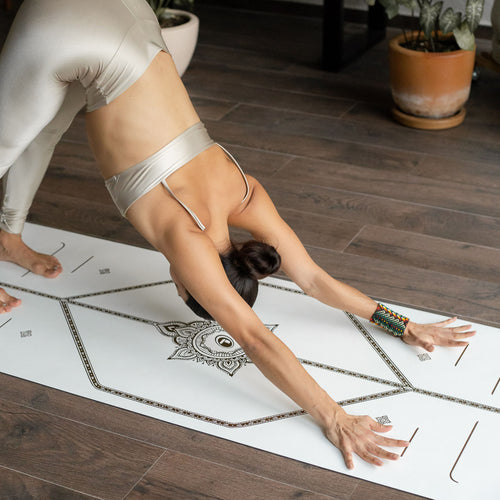Could your yoga practice be more eco-conscious? These expert tips will ensure that the yoga that helps keep your body and mind healthy doesn’t harm the planet.
Yoga’s Connection to the Environment
Yoga is a practice that enhances your awareness, both of yourself and of the outside world.
In a yoga class, you are often asked to bring your attention to your navel, your big toe, or the crown of your head. This creates body awareness.
At the same time, yoga also raises your awareness of the connectedness of all living things. The more you practice, the more you think about how your actions affect the lives of others and the health of the planet.
It’s only natural, then, to bring your attention to how your yoga could be more eco-friendly. A practice that is so centred around interconnection should impact the Earth as little as possible.

5 Ways to Make Your Yoga Practice More Eco-Friendly
1. Choose an Eco-Friendly Yoga Mat
What’s the one thing you need to do yoga? Your mat. So, clearly, you need an eco-friendly one.
Many budget (and some high-end) yoga mats are made of PVC. Yes, the same polyvinyl chloride that is used for drainage pipes plus additives, including phthalates, to make it flexible.
A 2023 report commissioned by Beyond Plastics recommends against using PVC pipes in homes because of evidence that its carcinogenic and hormone-disrupting chemicals can leach into drinking water.
That’s probably not the kind of material you want in contact with your skin during yoga!
Additionally, when PVC is thrown away, it can rarely be recycled. It usually ends up in a landfill, where it can take hundreds, or even thousands, of years to break down into halogenated organic compounds, which can also be environmentally hazardous.
In other words, the less PVC in your life, the better.
Obviously, we’re partial to Liforme’s high-performance, sustainable combination of natural rubber and a very thin layer of proprietary eco-polyurethane. While PU is also a plastic, all plastics are not created equal. Our version is non-toxic and designed to break down in landfill conditions in 1-5 years, making it a far more sustainable option than other yoga mat materials.
2. Opt for Second-Hand or Sustainable Clothing
Just as some yoga mats are better for the planet, so is some yoga clothing.
With so many brands offering similar leggings and sports bras, it’s easy to get overwhelmed by choice and just go for one that’s popular or available via overnight shipping.
Instead, slow down, take a minute, and put your scrolling skills to work searching for yoga wear from ethical brands that prioritize sustainability.
If you’re not sure where to start, look at brands that are B Corp certified, which means they have been independently evaluated and meet high ethical and environmental standards.
Another way to turn your shopping cart green is to buy less clothing.
Instead of jumping on the latest drop, invest in a few key pieces that you can mix and match.
Shopping second-hand is also a good strategy to keep your wardrobe current while minimizing your impact. Many thrift shops have a broad selection of lightly worn athletic clothing.
Also, remember that washing your yoga togs in cold water and line drying them uses less power and makes them last longer!
3. Avoid Plastic Water Bottles and Single-Use Packaging
This advice seems as old as the hills of plastic despoiling our ecosystems and waterways. Yet, it bears repeating because people can’t seem to break the bottled water habit.
If your water source is legitimately compromised, use bottled water. That’s what it’s for.
Otherwise, pick out the cutest reusable bottle you can find and take it with you everywhere.
If this leads you to stop accepting other single-use plastic packaging and convenience items, all the better.
4. Walk, Bike, or Take Public Transport to Class
The idea here is simple: use your car less when possible. Sometimes you have to drive, of course. But, if you can, get there another way.
Keeping it local can have many side benefits: a little more movement in your day, plus getting out and about in the neighbourhood reduces isolation and fosters community.
5. Practice Outdoors to Connect with Nature
Every now and then, on a particularly lovely day, take your mat outdoors to your garden, balcony, or local park.
Instead of going inward and trying to ignore distractions, go outward and observe every sensation of your body connecting to nature.
Feel the sensation of air on your skin, maybe the warmth of the sun. Listen to every bird and the wind in the trees. Smell grass and the earthiness of decomposing leaves. Take a breath into your lungs, filling them with everything that surrounds you. Exhale and feel that you, too, are part of this planet.
Yogi’s Tip
When I started doing yoga, I never expected it to have such a profound effect on my worldview. I was just there to do a few stretches! But, over time, I began to feel that a lot of the ‘yoga industry’ was incompatible with a more yogic way of life. If you’ve felt the same way, perhaps it’s time to bring your practice more in line with your ideals.
 Towards a Greener Future
Towards a Greener Future
You may wonder if changing these few little things can make a difference. The answer is a resounding yes.
Individual actions become collective trends that have the power to influence the economics and politics of environmentalism. It’s more imperative than ever to start acting for the greater good, one yoga mat at a time.
FAQ
Do you have any other Eco-Friendly Tips?
We do! Check out our 4 Totally Doable Household Eco Tips for ideas that save energy (and money!) around the house.


































